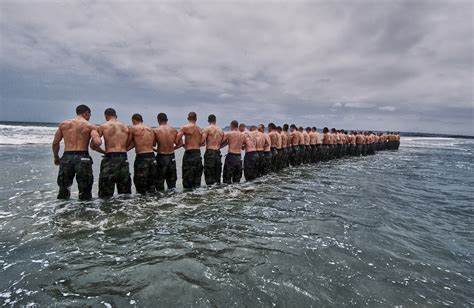“Hell Week” Health Worries: How Navy SEAL Training Regimen has Led to Medical Malpractice and Death

Image Courtesy of Google Images
Five and a half days of pure hell. 132 hours and 7,920 minutes of excruciating pain. Roughly 210 men at the start, but numbers dropping as days pass. With over 20 hours of physical training per day and less than 4 hours of sleep per night, swimming in ice-cold temperatures, covering over 200 miles on land and water, and causally coughing up blood, this initiation process is known in the Navy SEAL as “Hell Week.” This training tests your physical and mental endurance. Less than 20% successfully make it through this brutal training phase. Many walk out of the week with hypothermia, sleep deprivation, heatstroke, hallucinations, broken bones, concussions, and near drownings. Some are even hospitalized and intubated.
Many participants in the SEAL training program faint and collapse due to the intense physical and mental demands of the program. They are then subjected to abusive treatment by instructors, such as kicks, beatings, and shoves, worsening the medical conditions they accumulate from the week. However, if a SEAL does require medical attention and has to go to the hospital, they are often forced to leave the program and take on a low-level job, such as working at a snack shack nearby. This can be a devastating change for the individual, particularly after investing so much time and effort into the training.
The intense training methods used by the Navy have been met with criticism and have resulted in deaths, raising concerns about whether the level of training has become excessive. Although the Navy refuses to disclose death rates, since 2001, it has been roughly calculated that at least 17 men have died in “Hell Week.” More recently, in 2022, 24-year-old Kyle Mullen died hours after completing the final training for “Hell Week.” He died due to acute pneumonia and cardiac arrest. Shortly after, another three SEALs were hospitalized due to the intensity of “Hell Week.” Even so, it’s been 11 months since Kyle’s death and no one has been held accountable. The Navy has only deflected the blame. In an interview with the New York Times, Kyle’s mom said, “They say it’s training, but it’s torture. And then they didn’t even give them the proper medical care. They treat these guys worse than they are allowed to treat prisoners of war.” The officials normalized Mullen’s conditions. His body was grotesquely bloated with edema to the point where he was unrecognizable for several days prior to his death. Despite his obvious and severe suffering, the instructors failed to take him to a hospital for proper treatment.
Sadly, joining the military means facing certain risks like extreme injuries and death, and it can be difficult to hold the institution legally responsible. The 2020 National Defense Authorization Act (NDAA) contains several provisions that may limit an individual’s ability to sue the military or the federal government for damages. This provides that military personnel and contractors who are engaged in combat are immune from civil lawsuits for injuries or deaths that occur as a result of their actions and are permitted to sue in federal court.
It is clear that there is a delicate balance between providing the necessary training to prepare Navy SEALs for any situation and subjecting them to excessive abuse that leads to serious injuries and even death. The Navy SEALs’ training regimen, characterized by its arduous nature and known to have resulted in fatalities and long-term physical and mental health issues, raises concerns about the normalization of such drastic measures within this elite military unit. Despite the gravity of the situation, there appears to be a lack of action taken to prevent further injuries and deaths, and it is disappointing to see this vital military unit lack proper safety protocols. This mental and physical test has been taken to new extremes, so much so, that life-threatening injuries are occurring far too regularly and serious dangers are taken as a sign of weakness, causing these men to push themselves to unattainable limits. Thus, this strenuous training needs to be reevaluated for the better and expose the true nature of the Navy’s program.
The Navy SEAL establishes this training with the intention of preparing their members for any treacherous encounter that might come their way, by testing their ability to work as a team and maintain their focus and determination in difficult conditions. SEAL members in the past have been punished for calling 911 for a friend. Most of the time people are unable to receive any medical help at night when most medical scares occur.
Additionally, the mental toll of “Hell Week” can be significant. Candidates are pushed to the brink of their physical and mental endurance, and the program can lead to long-term psychological damage, such as depression and post-traumatic stress disorder. The suicide rate among Navy SEALs has been a concern in recent years. However, there is limited publicly available data on the specific suicide rates among Navy SEALs needed to understand the factors that contribute to suicide. Still, there is no doubt that the abusive demoralizing language and the critical injuries they are forced to ignore. Another pressing issue is the high dropout rate. Many candidates start the training but don’t finish it, mostly due to injury. 1 in 5 Navy SEALs complete “Hell Week.” Most of the people who go through this brutal training don’t even finish, ultimately, making the harsh conditions and risks of injury unnecessary.
The Basic Underwater Demolition (BUD/S) section of the training has program flaws of its own, as over 40 Navy SEAL candidates have either tested positive or admitted to using drugs, and the Navy has been silent since. Most SEALs had been taking performance-enhancing drugs for years on end before this discovery within the last year. SEALs felt dependent on drugs to complete this portion of the training as it is viewed as nearly impossible to complete the week without illicit performance enhancers. Ultimately, this ruins the foundation of “Hell Week” when the small percentage that do pass the training phase are bolstered by steroids, beating out the few clean men.
Overall, Navy SEAL “Hell Week” may be effective in training elite soldiers, and difficulty is essential for producing the best of the best soldiers. Still, the potential perils it imposes on these candidates are not justified and have become a huge concern for the institution as a whole. It is crucial for the well-being of Navy SEALs that new and more effective safety measures are placed to protect candidates, minimize injuries, and avoid deaths.
Citations:
Philipps, Dave. “Death in Navy SEAL Training Exposes a Culture of Brutality, Cheating and Drugs.” The New York Times, The New York Times, 30 Aug. 2022, https://www.nytimes.com/2022/08/30/us/navy-seal-training-death.html

Grade: 12
Years on Staff: 4
Why are you writing for the Flintridge Press?
I am writing for the Flintridge Press because it gives me an opportunity...






